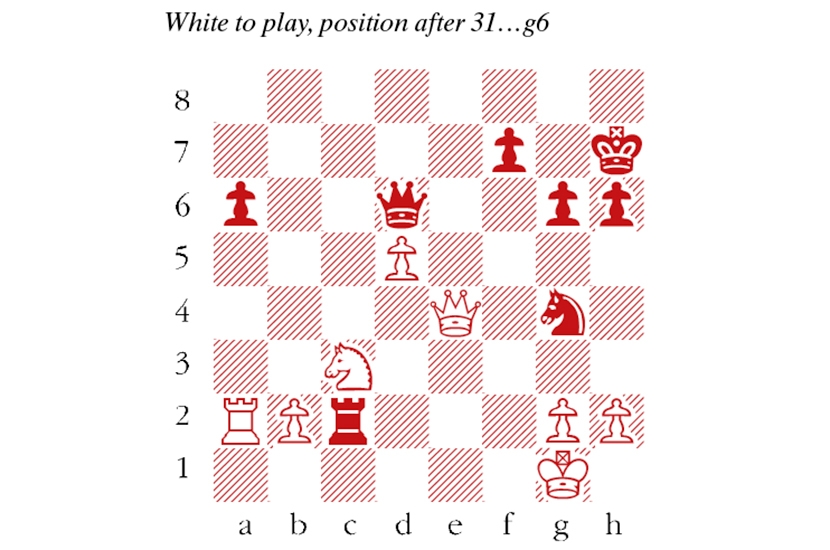Millions of people would see losing to Anand as a privilege rather than a disgrace. So it is simply astonishing that one lucky opponent, facing the Indian star in an online simultaneous display, squandered the opportunity by cheating.
‘Checkmate Covid, celebrity edition’, hosted earlier this month by Chess.com, was supposed to be a lighthearted event, with a handful of Indian celebrities taking on the former world champion to raise funds to tackle the pandemic in India. Billed as India’s youngest billionaire, Nikhil Kamath is the co-founder and CIO of Zerodha, an Indian brokerage company, but his claim to have been a chess champion in his youth looked doubtful when he blundered a pawn on the very first move.
After that, his moves were conducted with superhuman precision, and 30 moves later Anand’s position was hopeless (see diagram). Capturing either the knight (as in the game) or the rook both lead to disaster. But it didn’t take long for the audience to notice how closely Kamath’s moves had matched the suggestions of a chess computer. (Nor was he the only opponent displaying suspicious levels of ‘accuracy’.)
In the final position, Anand might have tried to continue the game exploiting the fact that Kamath had nearly run out of time. Instead, his gentlemanly resignation cast a spotlight on the incident.
Kamath seemed at first unaware of the sporting norms he had trampled on, implying with his tweet that it was all part of the fun. ‘I had help from the people analysing the game, computers and the graciousness of Anand sir himself to treat the game as a learning experience.’
Anand would certainly have sensed the deception while the game was still being played. With devastating courtesy, he made it clear that he expected no such thing from his opponents: ‘I just played the position on the board and expected the same from everyone.’ Soon after, Kamath saw sense and publicly apologised.
Viswanathan Anand–Nikhil Kamath et al
Checkmate Covid Charity Simul, June 2021
1 Nf3 e5? Awful! 2 Nxe5 d6 3 Nf3 Nc6 4 d4 Nf6 5 d5 Ne5 6 Nc3 Be7 7 e4 O-O 8 Be2 c6 9 O-O cxd5 10 exd5 a6 11 Re1 b5 12 a3 h6 13 Nd4 Bd7 14 Bf4 Rc8 15 Bf3 Qb6 16 Bxe5 dxe5 17 Nc6 Bc5 18 Qe2 Rfe8 19 Nxe5 Rxe5 20 Qxe5 Bxf2+ 21 Kf1 Bxe1 22 Qxe1 b4 23 axb4 Qxb4 24 Ra2 Bb5+ 25 Ne2 25 Nxb5 Qc4+ wins, since the rook on a2 is no longer protected. 25…Qd6 26 Kg1 Rxc2 27 Nc3 Bd7 28 Qe3 Bg4 A very strong move! 29 Bxg4 Nxg4 30 Qe8+ Kh7 31 Qe4+ g6 (see diagram) 32 Qxg4 Anand certainly knew this was bad, but there is nothing better. 32 Qxc2 Qxh2+ 33 Kf1 Ne3+ wins the queen. Qc5+ 33 Kh1 Rc1+ 34 Nd1 Qxd5 White resigns
Compare this fiasco with a game played by Bill Gates against Magnus Carlsen on a Norwegian talk show a few years ago. Carlsen had just 30 seconds to win the game, and went for the jugular. Gates conceded with a smile, as amused as the audience by his undoing.
Bill Gates–Magnus Carlsen
Skavlan studio, 2014
1 e4 Nc6 2 Nf3 d5 3 Bd3 Nf6 4 exd5 Qxd5 5 Nc3 Qh5 6 O-O Bg4 7 h3 Ne5 8 hxg4 Nfxg4 Carlsen has gambled on a quick attack, which could be refuted with the subtle move 9 Re1! Instead, the game ended with a bump: 9 Nxe5 Qh2 mate






Comments